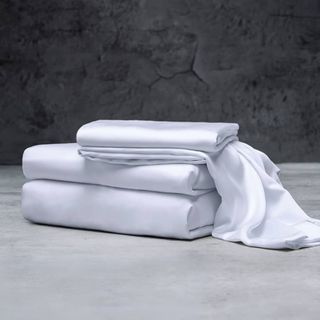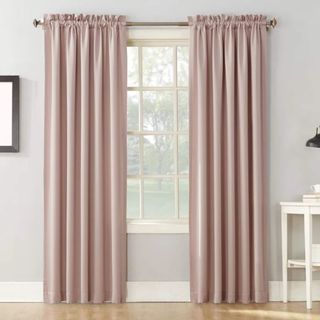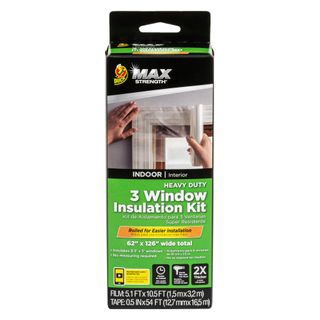Struggling to sleep in the cold weather? These are the mistakes you could be making that are affecting your routine
Bedding experts and sleep scientists reveal the most common cold-weather sleeping mistakes you're probably making, as well as easy, affordable fixes


The countdown to Christmas is on, and celebrations are in full swing. The late nights and the big meals make a welcome change from the daily grind, but they might be impacting your sleep quality.
I asked an expert panel of bedding designers and sleep scientists how to sleep better in cold weather. Their advice ranges from making easy, affordable upgrades to better insulating your bedroom to investing in warm bedding to see you through the winter.
Cold weather sleeping mistakes − how to fix your sleep routine
These are just a few of the cold-weather sleeping mistakes you might be making. My expert panel offers simple steps to get better sleep in cold weather, so that you can keep warm in bed this winter.
1. Not switching to your winter duvet

'Before you drop hundreds of dollars on a space heater, I would first recommend looking at your current bedding and seeing if it's suitable for the winter,' says Chris Ailey, Founder of Laud Sleep. 'If you're wondering when to switch to a winter comforter, I can't give you a set answer. It depends what the weather is like and how hot or cool you tend to run.'
If you're struggling to sleep in the cold, you need the best warm comforter. Feather and down are best for retaining heat, and all the little air pockets create natural loft for a nice, puffy bedspread. If you're allergic to feathers, you should consider down alternatives: this could look like anything from moisture-wicking wool to cozy microfiber fills.
Once you've settled on a fill type, it's time to work out which duvet tog you need. 'Tog' stands for 'thermal overall grading' and it's a measure of how warm a duvet will keep you, on a relative scale of 1 to 15. Chris says that 'A 13.5 tog duvet is typically the best option for the winter or anything above 10 as a good rule of thumb. Exactly where your duvet insert falls on that scale could depend on the temperature of your bedroom and how cold you get during the night.'

This down comforter comes in three weights to suit every style of sleeper. I recommend the Ultra-Warm option for cold sleepers and winter weather. Filled to the brim with fluffy down clusters, there's plenty of puff, and none of the scratchy filaments you get from feather duvets.

If you're allergic to feathers, or you prefer not to purchase vegan products, I recommend down alternative. This microfiber comforter is far more affordable than organic wool or breathable bamboo, and it's bolstered by more than 2,000 verified five-star reviews on the Quince site.

According to the Woolroom Clean Sleep Report 2024, wool can hold up to 33% of its weight in water (or sweat), which should keep your bed and your body clean and dry. This is the best comforter for anyone who suffers from night sweats or hot flashes.
2. Sleeping under synthetic materials

'The materials you sleep in can greatly affect your comfort and restfulness,' says Sam Tamlyn, Sleep Expert at Shutterly Fabulous. 'Natural fibers, such as cotton or wool, are better at regulating body temperature and keeping you warmer throughout the night.'
Out of all the bed sheet types, polyester is the worst for cold sleepers and winter weather. 'Polyester traps moisture,' explains Sam, 'which can leave you feeling colder.' You're looking for moisture-wicking materials to move sweat away from your body and out of your bed.

These are the best bed sheets for eco-conscious shoppers. Made from bamboo lyocell and grown with 100% rainwater, the Signature Sateen Sheet Set is free from toxic solvents, pesticides, and fertilizers. These sheets feel soft and silky: an ultra-luxe upgrade from your tired old set.

How cotton looks and feels depends on the way in which the fabric is woven. Where cotton percale is crisp and cool, ideal for hot sleepers, cotton sateen is a better bet for winter weather. These sateen sheets come in a wide range of colors, prints, and patterns to complement any color palette.

These are the first sheets I ever sampled for H&G. They arrived in the middle of January, and I slept under them all through winter into spring. Each flat sheet, fitted sheet, and pillowcase is made from bamboo viscose, which is a great thermoregulator, and felt silky smooth, even after a few washes.
3. Leaving the windows open

'While ventilation is important, windows shouldn't be opened for more than 10 minutes a day in very cold temperatures,' says Sam. 'Leaving windows open during cold weather can significantly lower your room temperature, making it difficult to stay warm.'
'Thermal curtains or shutters are great for providing an extra layer of insulation,' Sam continues, 'allowing you to keep your windows open for slightly longer without impacting room temperature too much.'
Chris concurs that 'cold temperatures can detrimentally affect your REM sleep state, which is important for learning, memory, and emotional processing. Keeping the room temperature slightly warm is important for more than just comfort.'
'However, it's also important not to be too warm during sleep,' says Chris. It's a fine balance: 'If you do need some extra coolness in the room, crack the window open slightly, or invest in a room fan for a light breeze.'

Replace your thin blinds or shutters with a pair of nice, thick thermal curtain panels. NB: these are room-darkening curtains, rather than total blackout. They come with thermal insulation and noise cancellation, but they can't block out all light and sound.

The best curtains look just as good open as they do closed. I love this set from Lulu & Georgia: the long, lean white, and gold stripes are a sure-fire way to make your bedroom look bigger while blocking out cold air.

If you're working with single-glazed windows or persistent drafts, you might want to pick up a window insulation kit to solve the problem at source. This Duck Max Strength Kit gets rave reviews on Walmart: 'I've used several similar products over the years and this was by far the easiest to use,' reads a recent review. 'I was also able to cover three windows of various sizes with one pack.'
'Your choice of sleepwear is also important, as well as the materials they are made out of,' says Chris. 'Polyester, for example, can trap heat and moisture, leading to discomfort, so you should look into some more comfortable nightwear to suit your needs.'
'You can also try adding extra layers to your bed during really cold nights, so consider looking into thick wool blankets for enhanced warmth and comfort overnight.'
Sign up to the Homes & Gardens newsletter
Design expertise in your inbox – from inspiring decorating ideas and beautiful celebrity homes to practical gardening advice and shopping round-ups.

Emilia is our resident sleep writer. She spends her days tracking down the lowest prices on the best mattresses and bedding and spends her nights testing them out from the comfort of her own home. Emilia leads a team of testers across America to find the best mattress for every sleep style, body type, and budget.
Emilia's quest to learn how to sleep better takes her all around the world, from the 3Z mattress factory in Glendale, Arizona to the Hästens headquarters in Köping, Sweden. She's interviewed luxury bedding designers at Shleep and Pure Parima, as well as the Design Manager at IKEA. Before she joined Homes & Gardens, Emilia studied English at the University of Oxford.
-
 5 sofa styles to avoid if you want a timeless living room
5 sofa styles to avoid if you want a timeless living roomThese sofa styles are the ones to avoid if you want to future-proof your living room, according to interior designers
By Ruth Doherty Published
-
 5 low-energy and useful tasks to try instead of doom-scrolling – this brain hack will break bad habits
5 low-energy and useful tasks to try instead of doom-scrolling – this brain hack will break bad habitsExperts urge you to try it for your wellbeing
By Chiana Dickson Published